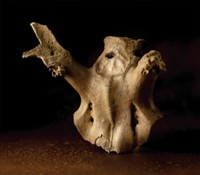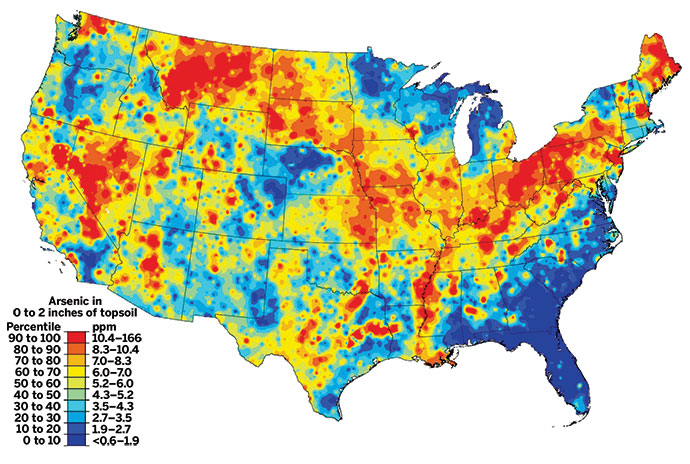Advertisement
Grab your lab coat. Let's get started
Welcome!
Welcome!
Create an account below to get 6 C&EN articles per month, receive newsletters and more - all free.
It seems this is your first time logging in online. Please enter the following information to continue.
As an ACS member you automatically get access to this site. All we need is few more details to create your reading experience.
Not you? Sign in with a different account.
Not you? Sign in with a different account.
ERROR 1
ERROR 1
ERROR 2
ERROR 2
ERROR 2
ERROR 2
ERROR 2
Password and Confirm password must match.
If you have an ACS member number, please enter it here so we can link this account to your membership. (optional)
ERROR 2
ACS values your privacy. By submitting your information, you are gaining access to C&EN and subscribing to our weekly newsletter. We use the information you provide to make your reading experience better, and we will never sell your data to third party members.
Environment
Trees Testify To Pollution
Tree rings help scientists trace the source and timing of chemical leaks and spills in the environment
by Rachel Petkewich
September 8, 2008
| A version of this story appeared in
Volume 86, Issue 36

TREES HAVE STORIES to tell. Within their annual growth rings are records of drought and deluge, but scientists can also use them to reconstruct environmental pollution events. Tree rings can be used to determine how far a pollutant plume has traveled in soil or groundwater. And because each ring is essentially a time stamp, scientists can use tree rings to figure out when that pollution occurred.
Dendrochemistry, the chemical analysis of precisely dated tree rings, is proving to be a key tool in tracking environmental pollution. Scientists can use dendrochemistry, for example, to track how acid rain affects soil health, estimate when petroleum products leaked from an underground tank or pipeline, or approximate when chlorinated solvents were spilled. Lawyers trying environmental cleanup cases are now invoking tree-ring data to make their cases.
Tree-ring sampling is less expensive than drilling sample wells, and as a pollution-monitoring strategy, it's "becoming more and more in vogue" because the sampling equipment is simple, says Don A. Vroblesky, a research hydrologist at the U.S. Geological Survey in South Carolina. Vroblesky has used cores from trees to study contaminants in groundwater.
Tree rings can be dated in much the same way as ice and sediment cores. Ice cores pulled from polar regions and sediment cores retrieved from the ocean hold information on hundreds of thousands of years' worth of environmental history. "But for questions involving year-to-year or decade-to-decade events, the tree-ring record is the record that we have," according to Kevin T. Smith, a plant physiologist at the U.S. Forest Service's Northern Research Station, in Durham, N.H. Smith presented at a symposium sponsored by the Division of Agrochemicals at the American Chemical Society national meeting in Philadelphia last month.

Scientists assign dates to tree rings by analyzing ring widths with a microscope. In some cases, markers in tree rings can even be dated to within a few weeks during the growing season.
At the meeting Smith noted that although analytical techniques are becoming more sensitive and precise, scientists interpreting the data also need to understand how tree biology affects dendrochemical patterns.
Most trees grow by making a new wood ring each year. They absorb water and nutrients through their root systems, and if chemicals or metals contaminate that water, trees take up those contaminants, too. Trees deposit some contaminants in their wood structure or on the surface of wood cell walls, and scientists use elemental markers in tree rings to date pollution events.
TO ANALYZE rings scientists need to take a sample from a live tree by removing a small core from the tree's trunk. Core width and length vary on the basis of the type of study, but because core diameters are usually smaller than 1 cm, removing cores doesn't threaten the survival of otherwise healthy trees, according to Smith.
Vroblesky and coworkers pioneered the use of tree-core analysis for applications such as mapping out plumes of chlorinated solvents in groundwater. In addition to being inexpensive, cores record chlorinated solvents at low concentrations, and they can be used to track contaminants at sites where ground drilling is dangerous, such as in fields known to have buried bombs, or where drilling is impossible, such as in swamps.
Earlier this year, Vroblesky, in cooperation with the Environmental Protection Agency, completed a guide on how to use tree coring to track subsurface volatile pollutants. After Vroblesky collects the cores, he places each one in a separate vial and heats it or stores it overnight so the core will release volatile organic compounds into the vial's headspace. He then analyzes a sample of the vapor by gas chromatography. By tracking the ratio of parent compounds to daughter compounds, he can obtain valuable information on contaminant degradation across a site.
Smith is interested in using tree cores to understand better how acid rain affects soil and trees. One link is calcium, an essential element that trees obtain from soil. When acid rain deposits sulfates and nitrates, primarily from fossil fuel combustion, onto soil, the acidic anions are neutralized by basic cations such as calcium, which then are not available to trees.
Smith measures calcium, as well as other elements, in tree rings by nondestructive surface techniques such as energy-dispersive X-ray fluorescence (EDXRF). In collaboration with Jean-Christophe Balouet, a principal scientist with Environment International, in Orrouy, France, Smith has also studied how to combine element concentrations derived from EDXRF with historical information about the site to derive when a chemical was released into the environment.
Balouet, who is also an associate editor of the journal Environmental Forensics, provides tree-ring evidence for court cases regarding liability. He says that the majority of his cases involve fossil fuel leaks, approximately 20% involve spills of chlorinated solvents including dry-cleaning fluids, and a few cases surround questions of metal contamination. Property owners or insurance companies usually request his expertise to do a study, and tree-ring evidence often helps settle disputes out of court, he says.
SCIENTISTS CAN use other techniques, such as direct-coupled plasma emission spectroscopy, for dendrochemical studies. But Balouet prefers EDXRF because he can document 35 elements in one analytical run. Then, by coupling the element data to the dated rings, he can figure out when contamination occurred.
For example, Balouet applied tree-ring analysis at a site in New Jersey to figure out when releases of three different petroleum compounds began. And in other cases, he used tree-ring dating to work out when heating oil spilled from tanks, and lawyers negotiated responsibility for the cleanups on the basis of tree-ring data and records stating who owned the tanks at that time.
Balouet's work is currently being used in litigation proceedings. He has worked on 131 trees for more than 40 cases involving sites in the U.S. and France. In cases of suspected petroleum leaks, for example, he looks for common fuel-based tracer elements such as sulfur, which is deposited even if the fuel has been partially desulfurized, he says. Vanadium and iron are examples of elements that indicate historically documented gasoline additives. And chlorine is a marker for chlorinated solvents.
Although such elemental data are easy to collect from trees, scientists are still trying to figure out certain finer points of interpretation. Dating pollution via tree rings is more complex than it would be for interpreting ice or sediment cores because trees grow and change.
"Where you find the chemical signal in the ring is often not the year when the change actually occurred in the environment," Smith said. There are several reasons. "It takes some time for the pollution plume to migrate from the source to the tree," Balouet says. And then tree anatomy and physiology come into play, according to Smith. Trees move water and elements differently through new wood and old wood because each kind of wood has a slightly different structure and function that affects tree-ring chemistry.
Charlotte Pearson, a research associate in dendrochemistry at the Cornell University Tree-Ring Laboratory, in Ithaca, N.Y., says despite the fact that trees don't lay down passive records like ice cores, dendrochemistry is still a well-established approach for tracking pollution. She adds that the key to using tree rings is a good understanding of how elements behave in cellular structures of the tree.
For example, biologists don't know the nuances of how some metals act in wood. Until scientists get a better grasp of how metals react with wood cells, tree-ring data for tracking metal pollution should be regarded with some caution, says Shaun Watmough, an assistant professor of biology at Trent University, in Ontario.
Apparently, trees have yet to reveal all of their stories.




Join the conversation
Contact the reporter
Submit a Letter to the Editor for publication
Engage with us on Twitter